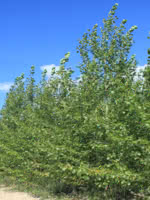Mon-Fri 9am - 5pm Mountain time
Walker Poplar vs Common Hackberry
Populus x Walker
Celtis occidentalis
NOT AVAILABLE THIS SEASON - MIGHT RETURN
Walker Poplar is a hardy prairie tree. A common shade tree, this fast-growing hybrid poplar works well in urban yards or shelterbelts.
In the past, Walker was one of the most popular species used in shelterbelts due to the wide spread that reduced the total number and cost of trees to plant. Despite the fuzz produced by this tree in the Spring it continues to be a popular and cost effective tree for field shelterbelts.
Another benefit of this species is the low branching. It can serve as a first row species that traps snow drifts. This makes it uniquely useful as a shelterbelt tree over other varieties.
Walker is one of the fastest growing hybrid poplar varieties we grow.
The Common Hackberry is a medium-sized deciduous tree that resembles the American Elm but is immune to Dutch Elm Disease. They are versatile and can adapt to a variety of growing conditions.
It produces purple-red, berry-like fruit with a large seed in the center. Both the sweet flesh, which tastes similar to dates, and the crunchy seed are edible. The fruit remains on the tree throughout the winter, offering a valuable food source for birds and other wildlife.
The Common Hackberry can also be a great addition to a pollinator garden. The tree itself is a host for the larvae of several butterfly species and the flowers provide a source of pollen and nectar.
Walker Poplar Quick Facts
Common Hackberry Quick Facts
In row spacing: 2.4 m (8 ft)

